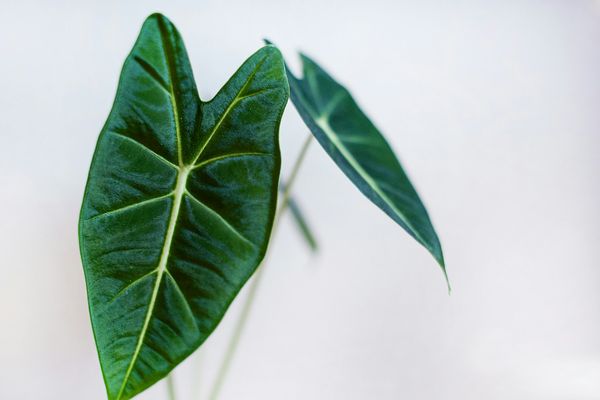Elephant Ear Care Guide
How to grow and care for Elephant Ear (Alocasia spp.)
Welcome to the world of Alocasia, an elegant and striking plant genus known for its large, stunning leaves that resemble the ears of an elephant, hence their common name, "Elephant Ear." Native to tropical forests in Asia and Eastern Australia, Alocasia spp. plants can transform any indoor space into a lush, green sanctuary. Let’s dive into how you can care for these beautiful plants and help them thrive indoors.

Disclosure: This content includes affiliate links, which means we may earn a commission if you click on a link and make a purchase. As an Amazon Associate, we earn from qualifying purchases. This comes at no extra cost to you and helps offset the cost of running Leafwise. Please read our disclaimer for more info.
Table of Contents
Care
Light
Alocasia plants thrive in bright, indirect light. While they can tolerate some direct sunlight, prolonged exposure can scorch their leaves. A location near a north or east-facing window is ideal. For variegated varieties, ensure slightly brighter indirect light to maintain vibrant foliage.
Watering
Keep the soil moist but not waterlogged. Water when the top 2-3 inches of soil feel dry to the touch. Overwatering can cause root rot, so ensure proper drainage. During winter dormancy, reduce watering significantly, as the plant’s water needs decrease.
Humidity & Temperature
Maintain temperatures between 65°F and 85°F (18°C to 29°C). Alocasia thrives in high humidity (above 60%), which helps prevent leaf browning. Use a humidifier or place the plant on a pebble tray with water to maintain moisture levels. Keep the plant away from drafts or sudden temperature changes.
Soil
Use a well-draining potting mix rich in organic matter and slightly acidic (pH 5.5 to 6.5). A mix of potting soil, perlite, and orchid bark works well, preventing compaction and allowing for aeration around the roots.
Fertilization
Feed your Alocasia every 2-4 weeks during the growing season (spring and summer) using a balanced, water-soluble fertilizer or one higher in nitrogen for larger leaves. Reduce or stop fertilization during the plant’s dormant period in fall and winter.
Maintenance
Pruning
Prune any yellowing, dead, or damaged leaves to maintain a healthy appearance and redirect the plant’s energy to new growth.
Cleaning
Wipe the leaves with a damp cloth to remove dust, ensuring they can absorb light efficiently. Clean leaves also help prevent pest issues.
Repotting
Repot every 1-2 years or when the plant becomes root-bound. Choose a pot 1-2 inches larger and refresh the soil to promote healthy growth.
Propagation
Alocasia is most commonly propagated through division:
- Timing: Propagate during the spring or early summer when the plant is actively growing.
- Division Process: Gently remove the plant from its pot and separate the clumps, ensuring each section has a healthy root system and at least one growth point.
- Replanting: Plant each division in a pot with fresh, well-draining soil. Water lightly and place in a warm, humid environment with indirect light.
Common Issues
Pests
Common pests: Alocasia can be susceptible to spider mites, mealybugs, and aphids.
- Prevention: Regularly inspect the plant and maintain high humidity to deter pests, as spider mites thrive in dry conditions.
- Solution: Wipe affected leaves with a mixture of water and mild soap or apply neem oil or insecticidal soap weekly until the pests are eliminated.
Root Rot
Cause: Overwatering or poorly draining soil.
- Prevention: Ensure the pot has proper drainage and allow the soil to dry out more between waterings, especially in lower light conditions.
- Solution: If root rot occurs, remove the plant from its pot, trim off any mushy or blackened roots, and repot in fresh, well-draining soil. Adjust watering practices to prevent recurrence.
Yellowing Leaves
Cause: Overwatering, insufficient light, or nutrient deficiency.
- Solution: Check the soil moisture and adjust watering accordingly. Move the plant to a location with bright, indirect light, and consider applying a balanced fertilizer during the growing season.
Brown Leaf Tips
Cause: Low humidity, inconsistent watering, or exposure to tap water containing salts.
- Solution: Increase humidity using a humidifier or pebble tray. Water consistently and use distilled or filtered water to prevent salt buildup.
Dormancy Period Issues
Cause: Alocasia often goes dormant during the colder months, causing leaf yellowing or dieback.
- Solution: Reduce watering and stop fertilization during this period. Keep the plant in a warm, humid environment, and resume regular care when new growth emerges in spring.
By following these care guidelines, your Alocasia will grow healthy and strong, bringing a touch of tropical elegance to your indoor space.
Toxicity Warning
Alocasia plants contain calcium oxalate crystals, which are toxic if ingested by humans or pets. Symptoms include mouth irritation, swelling, and digestive discomfort. Keep the plant out of reach of children and pets, and wash your hands after handling it to prevent skin irritation.
